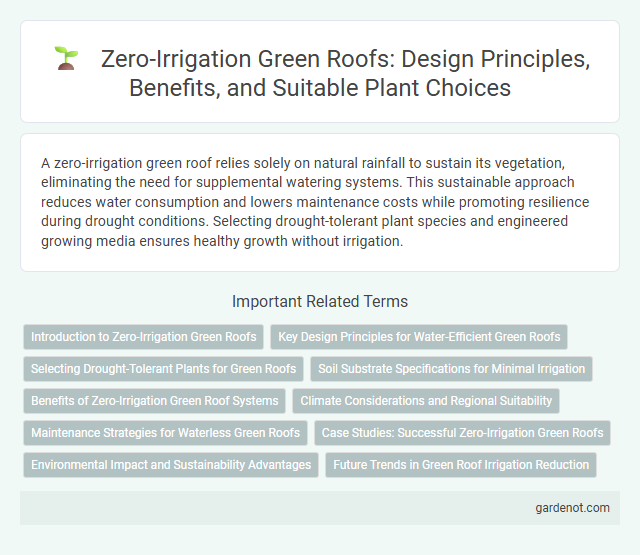A zero-irrigation green roof relies solely on natural rainfall to sustain its vegetation, eliminating the need for supplemental watering systems. This sustainable approach reduces water consumption and lowers maintenance costs while promoting resilience during drought conditions. Selecting drought-tolerant plant species and engineered growing media ensures healthy growth without irrigation.
Introduction to Zero-Irrigation Green Roofs
Zero-irrigation green roofs utilize drought-tolerant plant species and advanced substrate technology to thrive without supplemental watering, significantly reducing water consumption in urban environments. These systems employ engineered soil mixes with high water retention capacity and select native or succulent vegetation adapted to local climate conditions. Implementing zero-irrigation green roofs enhances building insulation, mitigates urban heat island effects, and lowers maintenance costs compared to traditional irrigated green roofs.
Key Design Principles for Water-Efficient Green Roofs
Zero-irrigation green roofs maximize water efficiency by incorporating drought-tolerant native plants, high-quality engineered lightweight growing media, and precise slope design for optimal rainwater retention and runoff control. Key design principles include selecting substrates with high water-holding capacity and porosity, implementing layered drainage systems to prevent waterlogging, and positioning vegetation to create natural shade and minimize evapotranspiration. These strategies collectively enhance resilience against drought, reduce maintenance needs, and ensure sustainable rooftop ecosystems.
Selecting Drought-Tolerant Plants for Green Roofs
Selecting drought-tolerant plants for zero-irrigation green roofs ensures sustainability by minimizing water use and maintenance needs. Succulents like sedum, native grasses, and Mediterranean herbs thrive under arid conditions, providing robust ground cover and heat resistance. These plants enhance roof longevity by reducing soil erosion and promoting natural insulation through their adaptive root systems.
Soil Substrate Specifications for Minimal Irrigation
Zero-irrigation green roofs rely on specialized soil substrates designed to maximize water retention and minimize irrigation needs. These substrates typically consist of lightweight, high-porosity materials such as expanded clay, perlite, and composted organic matter that enhance moisture-holding capacity while providing essential nutrients. Soil depth generally ranges from 8 to 15 cm, optimizing root growth and water conservation in drought-prone environments.
Benefits of Zero-Irrigation Green Roof Systems
Zero-irrigation green roof systems reduce water consumption by using drought-tolerant plants and advanced soil substrates that retain moisture efficiently. These roofs lower urban heat island effects, improve stormwater management, and decrease maintenance costs due to minimal irrigation needs. By enhancing energy efficiency and promoting biodiversity, zero-irrigation green roofs support sustainable urban development and resilience to climate change.
Climate Considerations and Regional Suitability
Zero-irrigation green roofs are designed to thrive in arid and semi-arid climates where annual rainfall is sufficient to sustain drought-tolerant plant species without supplemental watering. Regions with Mediterranean, desert, or steppe climates benefit most from these systems, reducing water consumption and maintenance costs. Selecting native succulents and hardy perennials enhances the roof's resilience to temperature extremes and prolonged dry periods, optimizing ecological and economic sustainability.
Maintenance Strategies for Waterless Green Roofs
Zero-irrigation green roofs rely on drought-tolerant plant species and engineered soils with high water retention capacity to minimize maintenance and eliminate the need for supplemental watering. Routine inspections focus on debris removal, erosion control, and ensuring plant health by monitoring for pests or diseases, reducing long-term upkeep costs. Sustainable maintenance strategies for waterless green roofs emphasize the use of native vegetation and optimal substrate depth to maintain ecosystem balance without irrigation.
Case Studies: Successful Zero-Irrigation Green Roofs
Case studies of zero-irrigation green roofs highlight successful implementations in arid urban environments where drought-resistant native plants thrive without supplemental watering. Projects like Chicago's City Hall rooftop demonstrate significant stormwater retention and temperature reduction, proving sustainability benefits while eliminating irrigation requirements. These examples validate the feasibility of zero-irrigation green roofs to enhance urban resilience and reduce maintenance costs in water-scarce regions.
Environmental Impact and Sustainability Advantages
Zero-irrigation green roofs significantly reduce water consumption by relying solely on natural rainfall, minimizing strain on municipal water supplies and decreasing runoff pollution. This sustainable roofing solution enhances urban biodiversity by providing habitats for native plants and insects, contributing to improved air quality and reduced urban heat island effect. The implementation of zero-irrigation roofs supports long-term environmental resilience by lowering carbon footprints and promoting resource-efficient landscaping practices.
Future Trends in Green Roof Irrigation Reduction
Zero-irrigation roofs represent a significant advancement in sustainable urban design by utilizing drought-resistant plant species and advanced soil substrates to minimize water consumption. Future trends in green roof irrigation reduction emphasize the integration of smart irrigation systems powered by real-time weather data and soil moisture sensors to optimize water use efficiency. Innovations in bioengineered plants and retention layers further enhance water retention, contributing to long-term resilience in urban heat mitigation and stormwater management.
Zero-irrigation roof Infographic

 gardenot.com
gardenot.com